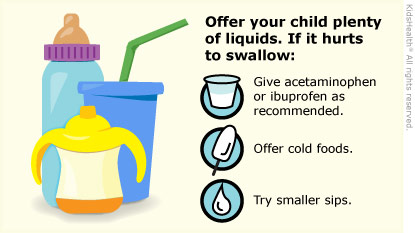Hand, Foot, and Mouth Disease: How to Care for Your Child
Kids with hand, foot, and mouth disease have a virus that causes painful blisters. The blisters may be in the mouth, on the hands and feet, and sometimes on other areas of the skin. Kids often have a fever, and they can get dehydrated because it hurts to swallow liquids. Make sure your child drinks plenty of liquids.


-
If your health care provider says it's OK, you can give medicine for fever or mouth pain. Use these medicines exactly as directed:
-
acetaminophen (such as Tylenol® or a store brand)
-
OR
-
ibuprofen (such as Advil®, Motrin®, or a store brand). Do not give ibuprofen to babies under 6 months old.
-
Don't give aspirin to your child. It could lead to a serious medical problem called Reye syndrome.
-
Offer your child plenty of water, ice pops, or cold milk. Cold liquids can help the mouth feel better. Avoid hot drinks, sodas, and acidic food (citrus juice, tomato sauce, etc.) because they can make the pain worse.
-
Let your child rest as needed.
-
Wash blisters on the skin with soap and lukewarm water. Pat dry and leave them uncovered. Use a fresh towel or paper towel each time.

Your child:
-
refuses to drink or doesn't want to swallow
-
is not interested in eating
-
is throwing up and can't keep liquids down
-
doesn't improve after a week
-
appears dehydrated; signs include:

Your child:

Can hand, foot, and mouth disease spread to others? Yes. Hand, foot, and mouth disease is caused by a virus called coxsackievirus. It is contagious and can easily spread from one person to another through mucus, saliva (spit), fluid from the blisters, or poop.
Hand, foot, and mouth disease is common in young children and can spread quickly through child care centers or schools. Sometimes adults can get the infection from a child. Children who have blisters should not return to child care or school until the blisters have healed.
How can someone avoid spreading the infection? All family members and child care providers should wash their hands well and often, especially after changing diapers. Use soap and warm water, scrub for at least 20 seconds, rinse, and dry thoroughly. If soap and water are not available, a hand sanitizer with at least 60% alcohol can be used. Clean tabletops, doorknobs, toys, and other hard surfaces with a cleaner that kills viruses.
Teach older children to wash their hands and cover their noses and mouths when coughing or sneezing. Children should not share cups and utensils.
How is it treated? A virus causes hand, foot, and mouth disease, so antibiotics won't make it go away. Help your child feel comfortable and prevent dehydration by encouraging your child to drink lots of liquids. If mouth blisters make it hurt to drink, you can give your child a pain medicine. Most kids feel better in less than a week.
Can my child get it again? Yes. It's possible for kids to get hand, foot, and mouth disease again. Good hand-washing habits can help protect your child.